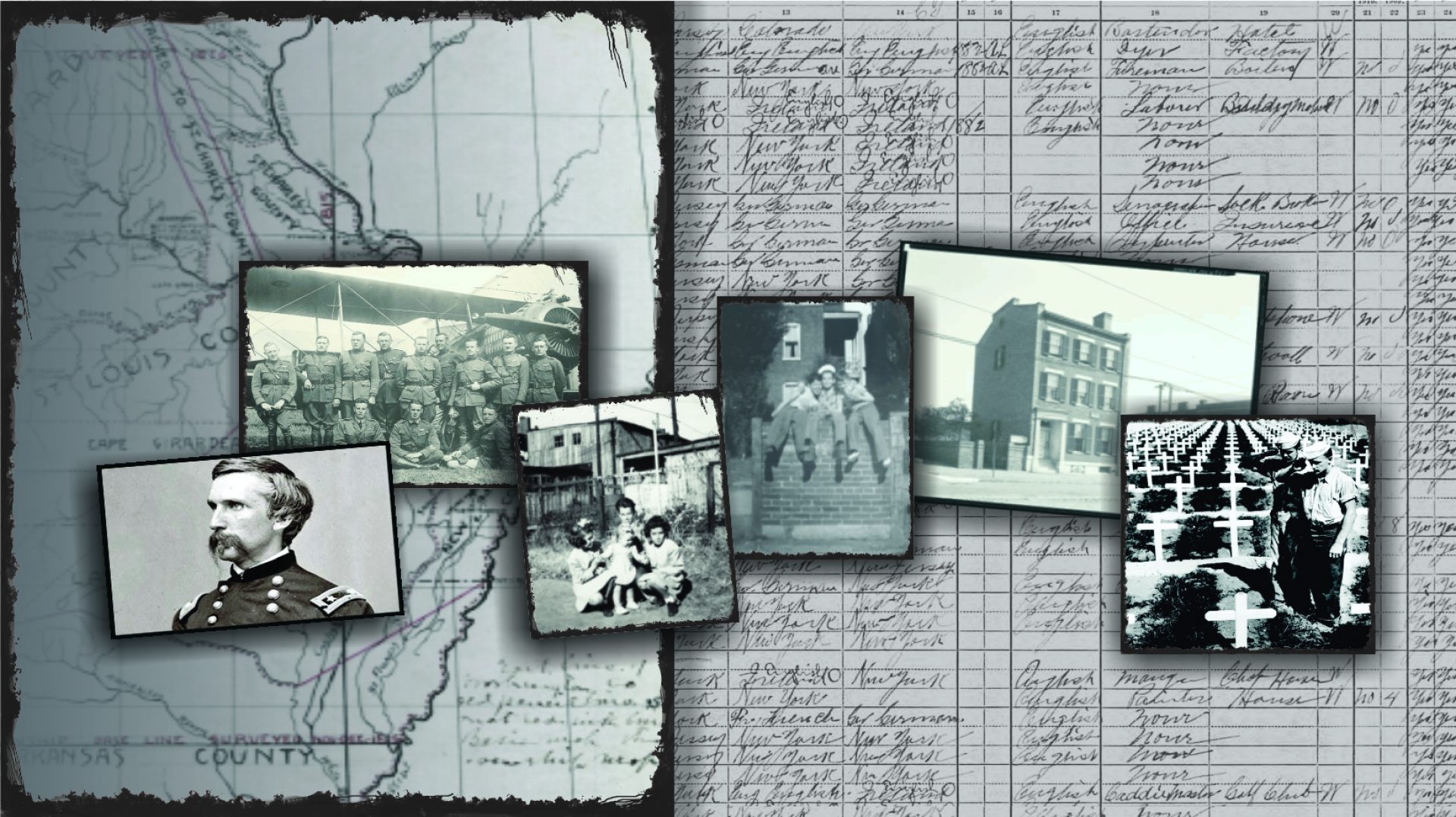To request your WWI veteran’s military service records click here: Request WWI veteran military service records
This article provides an overview of the archival WWI military service records which can be used to research WWI U.S. Army veterans. While it is well known that the 1973 fire destroyed many military service records of WWI army and air service veterans, it is possible to use a number of alternate records in order to rebuild and document the military service of individual WWI veterans. Bringing together all of the military service records in this article will allow you to essentially trace the steps of your WWI veteran. Let’s take a closer look at the available WWI military service records which you can use to research your WWI veteran.
Official WWI Military Service Records
The National Archives states that about 80 percent of WWI official Army military service records were lost in the 1973 fire. This means that a small percentage of WWI veterans do have official military service records which survived the fire. Official WWI military service records with pages that survived the fire are classified as ‘safeguarded military service records’ and these WWI service files can actually be viewed in person at the National Archives. Keep in mind that even though about 20 percent of WWI official service records survived the fire this is 20 percent of all records cumulatively…and not 20 percent of each file. You may find that your WWI veteran’s file is mostly intact, or you may find that his file only has one charred page which still remains. In most cases, the official personnel file of WWI veterans is completely lost due to the fire. For those WWI military service records with salvaged pages, it is common to find burn marks as well as water damage on many of the surviving pages.
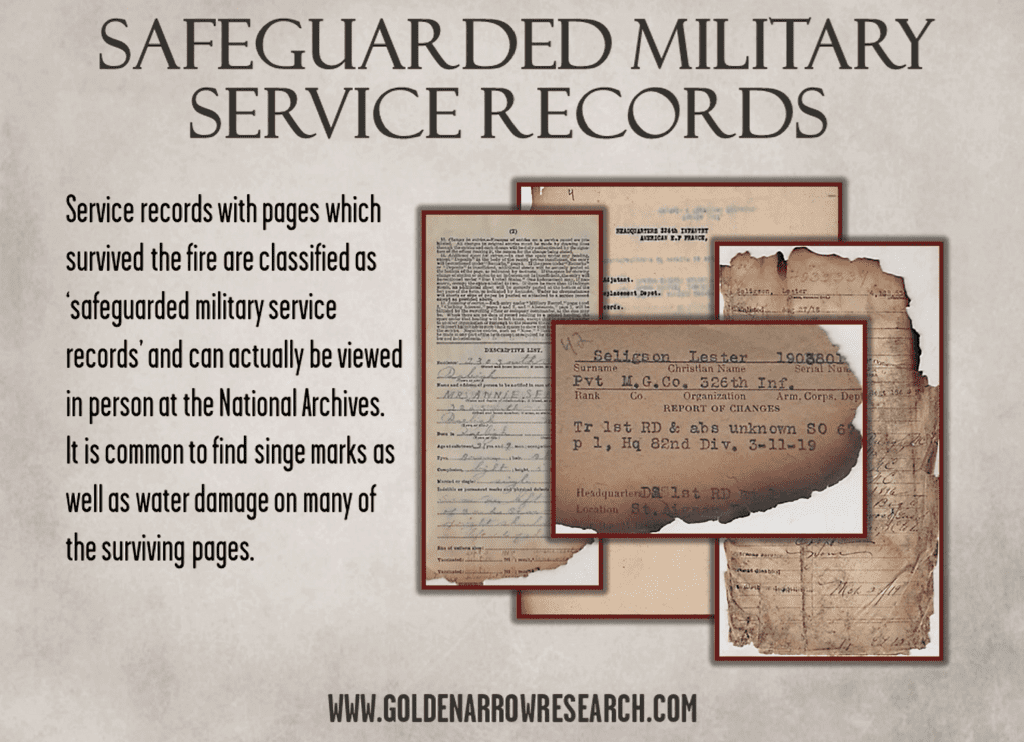
WWI Casualty-Burial Case Files
The WWI Burial File was a separate personnel file created for veterans who died in the service between 1915-1939. The focus of these files is primarily on the death and burial of the individual veteran. Many WWI Burial Case Files include correspondence regarding the repatriation of the WWI veteran’s remains and the transfer of their personal effects to the family. Some WWI Burial Files also include travel documents and photographs of widows or mothers who attended the federally sponsored pilgrimages of the 1920s. Burial case files often contain eyewitness accounts describing exactly how a veteran was killed in action. The military service records of the WWI casualty Burial Case File are essential for the research of a WWI veteran who was killed in action.
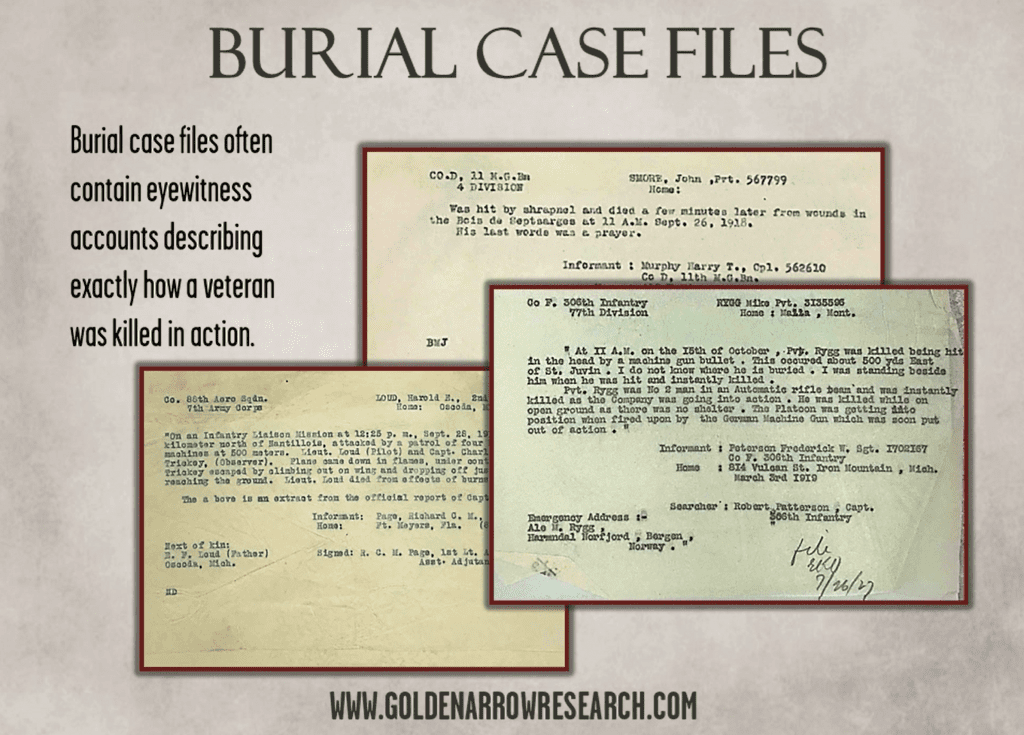
Reconstructed WWI Veterans Military Service Records
If your WWI veteran’s service records were lost in the 1973 fire the National Archives may have created what is known as a ‘reconstructed service file’. Most commonly these files consist of material that was sent to the archives after the fire as a way for the veteran or the veteran’s family to verify eligibility for certain benefits. It is common to find correspondence and sometimes actual service records (a copy of the honorable discharge was often used to prove eligibility for WWI veteran benefits).

WWI Auxiliary Military Service Records
Auxiliary service records of WWI veterans mainly consist of microfilmed WWI pay vouchers which are at the National Archives. Although sparse in detail, these WWI auxiliary service records do provide some helpful clues. Notice that the WWI final pay voucher can show us: the WWI veteran’s date of discharge, place of discharge, rank, serial number, and the veteran’s state of residency at the time of separation from the service.
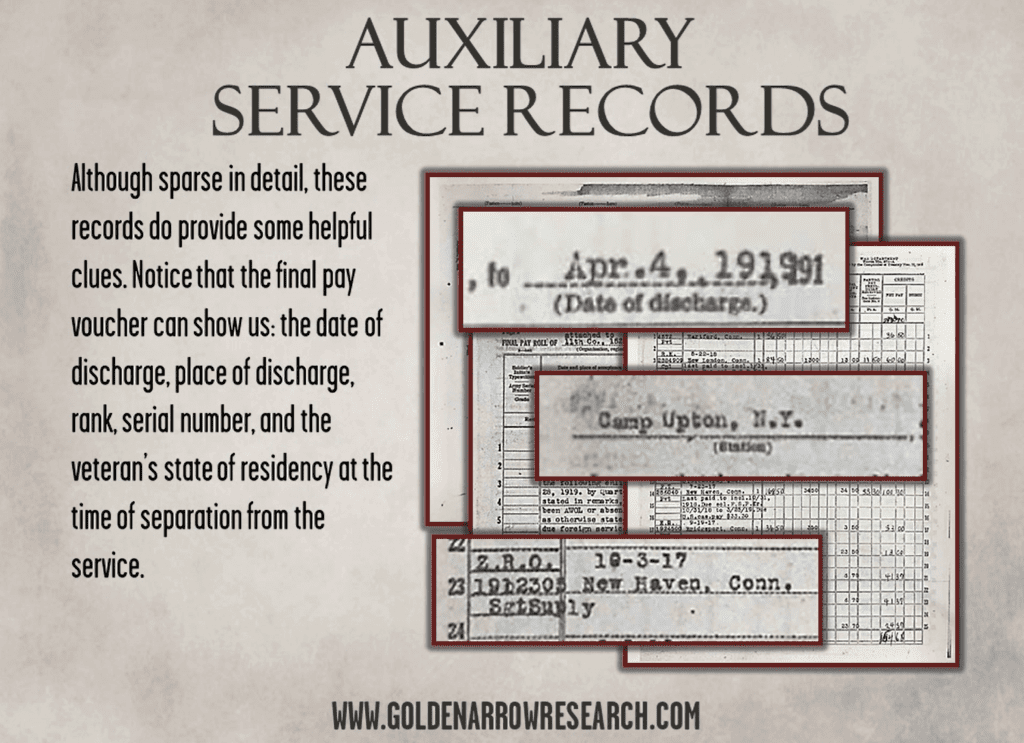
WWI Reports of Changes and Casualties
The WWI Reports of Casualties and Changes cover the daily losses for each company within army units. These reports often describe exactly how individuals were wounded or killed in action as well as the location where the casualty occurred. The WWI Reports of Casualties and Changes are maintained on microfilm among the unit records housed at N.A.R.A., St Louis. The WWI Reports of Casualties are almost always typewritten making them easier to read than some of the other handwritten unit records from the WWI period. These WWI military service records are a must-have if you are researching a WWI veteran who was wounded or killed in action.
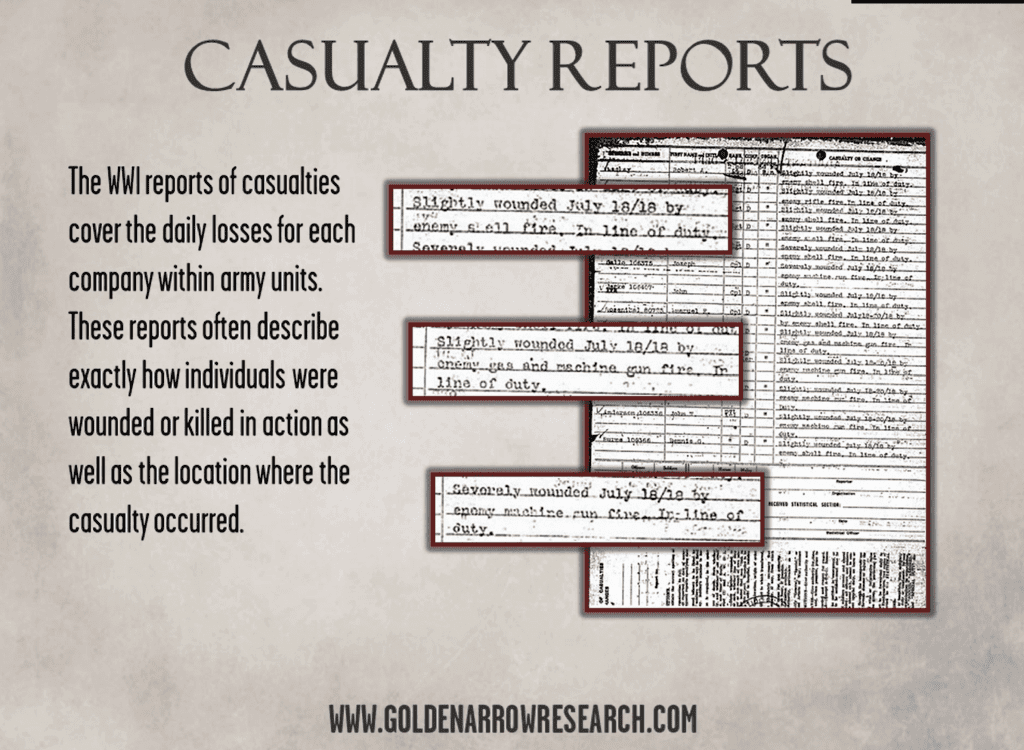
WWI Morning Reports
The WWI morning reports are company-level unit records that enable us to track WWI veterans day to day within the units to which they were assigned. These records document important details such as combat participation, military duties, promotions, ranks, as well as dates and locations where a veteran was wounded, injured, or killed in action. The WWI morning reports were handwritten, making them a challenge to decipher from the microfilm format in which they are maintained. Still, the WWI morning reports are an important tool for tracing the steps of individual WWI veterans since they show us exactly when the WWI veteran joined or left his unit.

WWI Muster Rolls
The WWI muster rolls provide a monthly list of the individual WWI veterans who were present within army units during the war. In addition to providing names and serial numbers of individual WWI soldiers assigned to specific units, these reports can also indicate status changes such as transfer to a new unit, injury or death.

WWI Award Cards
Many WWI army veterans were awarded medals for heroic actions performed in battle. The WWI award cards record the medals to which the individual WWI veteran was entitled. Most commonly these are for the award of the Purple Heart which was authorized in 1932 along with the Silver Star medal. Some WWI award cards provide a detailed explanation of the gallantry exhibited by the veteran while under fire.
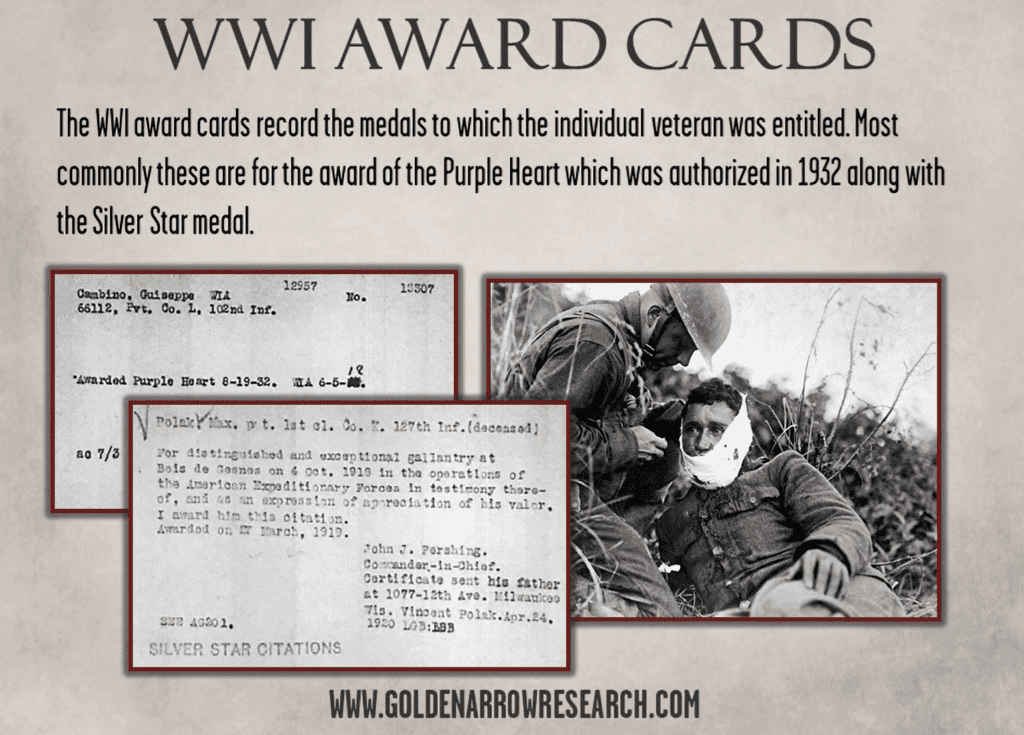
The WWI XC Claim File
Veteran’s Bureau pension WWI XC claim files were created when a WWI veteran or family member of a veteran applied for benefits from the government. In many instances, crucial documents from the WWI veteran’s service record (the honorable discharge for example) would have been duplicated and placed within the WWI XC Pension Claim File as a way to verify the veteran’s eligibility for benefits.
The WWI XC Pension Claim Files often contain a treasure trove of documents pertaining to medical treatment, civilian occupations, and disability payments. It is also common to find correspondence both official and handwritten within the WWI pension files.
This page from a WWI XC Pension file actually contains a statement from the individual WWI veteran describing how he was wounded in action during the Great War. Medical and military service records inside of the XC Claim File make the WWI era pension file essential for the research of all veterans (from all branches). The XC Claim files are a great tool for both military service research as well as genealogy.
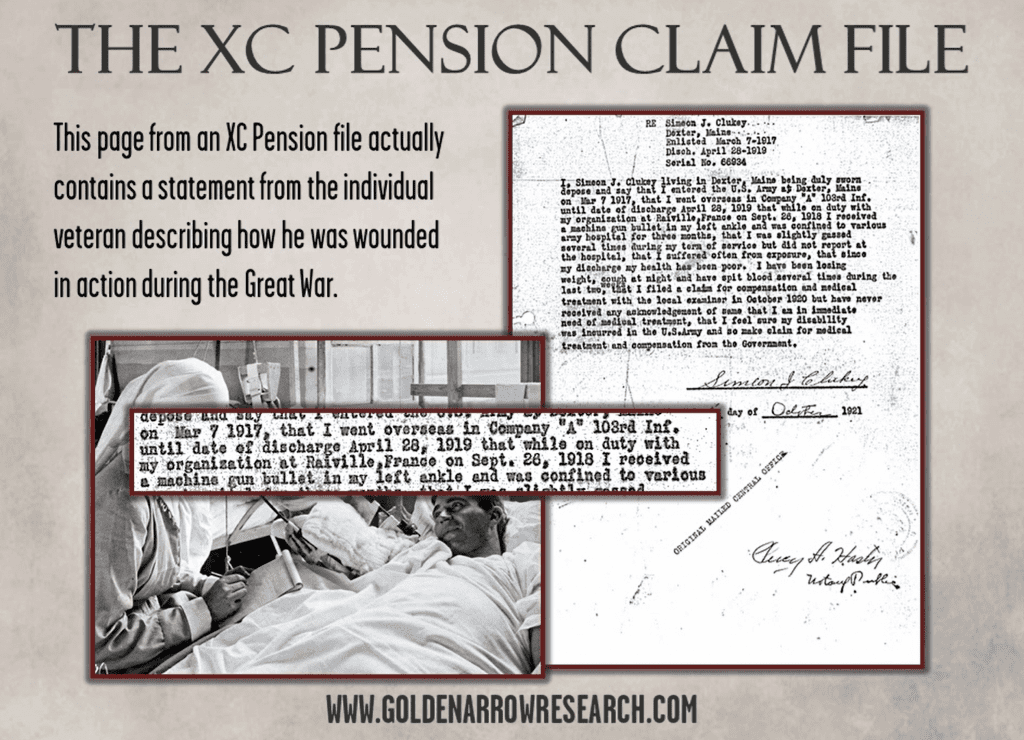
WWI After Action Reports and WWI Unit Histories
WWI after-action reports and unit histories are normally maintained at the battalion or regimental level. The after-action reports provide a detailed account of the combat actions of the unit to which a WWI veteran was assigned. WWI unit histories can also provide more detail on the activity of WWI support units that were not in combat. These operational unit records can help us to gain a better understanding of the wartime activities of individual WWI army veterans. When combined with the military service records of the individual WWI veteran the after-action reports can fill in the final piece of the puzzle.
Request Your WWI Veteran’s Military Service Records
[contact-form-7 id=”1708″ title=”Research a WWI Veteran”]
For those interested in further research in State level WWI records the WWI museum has a good breakdown here: WWI Research by State
